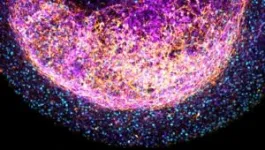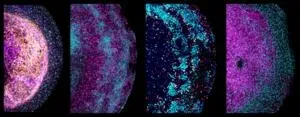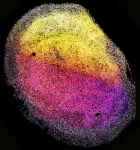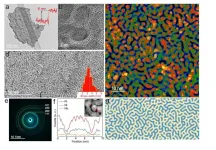(Press-News.org) SAN ANTONIO — January 8, 2024 —NASA and NOAA have selected Southwest Research Institute (SwRI) to develop QuickSounder, the first in a new generation of NOAA low-Earth orbit environmental satellites. Under the $54 million contract, SwRI will design and build the satellite and operate it for three years.
QuickSounder will kick off NOAA’s Near Earth Orbit Network (NEON) program. The Near Earth Orbit Network is a collaborative mission between NASA and NOAA. NASA will manage the development and launch of the satellites for NOAA, which will operate them and deliver data to users worldwide. NEON satellites will provide critical data to support weather forecasting, climate monitoring and environmental observation.
As a pathfinder mission and NOAA’s first environmental smallsat, QuickSounder will serve as a prototype for its next generation of environmental satellites. While environmental satellites usually take 10 years or longer to develop and launch, QuickSounder is expected to launch in mid-2026 – less than 27 months after the award. Improved development timelines will provide NOAA the opportunity to fly newer, more advanced technology instruments in the future.
“Our team is very excited to play such an important role in working with NOAA to develop their next generation satellite architecture,” said Michael McLelland, vice president of SwRI’s Space Systems Division
QuickSounder will carry NOAA’s Advanced Technology Microwave Sounder (ATMS) instrument, which provides information about the physical properties of Earth’s atmosphere – such as temperature and moisture - that heavily influence weather patterns. QuickSounder represents a leap forward in data latency for environmental satellites, delivering 95% of collected data within 30 minutes. Quicker data delivery will significantly improve NOAA’s weather forecasting ability.
Over the next two years, SwRI will design and build QuickSounder and integrate the ATMS instrument. Additionally, the Institute will perform environmental testing (thermal vacuum, vibration and acoustic) on the completed spacecraft to ensure that it will survive the launch and space environments. A little larger than a typical washing machine, the satellite will be 2.6 feet (80 cm) wide and 3.7 feet (114 cm) long and weigh about 465 pounds (211 kg), including the xenon propellant used by its small electric propulsion thruster.
SwRI will deliver QuickSounder to the launch site when it’s completed in 2026, perform launch vehicle integration, support the launch, and then will checkout and operate the satellite from the Institute’s Mission Operations Center in Boulder, Colorado, until 2029.
All design, fabrication and testing processes will occur within SwRI’s 74,000-square-foot Space System Integration Facility at its San Antonio headquarters. The facility is specifically configured to rapidly respond to commercial and government spacecraft needs, particularly small satellites targeted at emerging “new space” applications.
For more information, visit https://www.swri.org/industries/space-engineering or https://www.nasa.gov/news-release/nasa-awards-noaas-quicksounder-spacecraft-contract.
END
SwRI awarded $54 million contract to develop QuickSounder weather satellite
QuickSounder will launch the first in a new generation of NOAA low-Earth orbit environmental satellites
2024-01-08
ELSE PRESS RELEASES FROM THIS DATE:
Novel tissue-derived brain organoids could revolutionize brain research
2024-01-08
Press release – Princess Máxima Center for pediatric oncology
EMBARGO: 8 JANUARY 2024 AT 11:00 AM ET (US)
Scientists have developed 3D mini-organs from human fetal brain tissue that self-organize in vitro. These lab-grown organoids open up a brand-new way of studying how the brain develops. They also offer a valuable means to study the development and treatment of diseases related to brain development, including brain tumors.
Scientists use different ways to model the biology of healthy tissue and disease in the lab. These include cell lines, laboratory animals and, since a few years, 3D mini-organs. ...
SARS-CoV-2 BA.2.86 is less resistant to vaccine, but may be a problem in the lung
2024-01-08
COLUMBUS, Ohio – New research shows that the recently emerged BA.2.86 omicron subvariant of the virus that causes COVID-19 can be neutralized by bivalent mRNA vaccine-induced antibodies in the blood, which explains why this variant did not cause a widespread surge as previously feared.
However, the study in cell cultures showed this SARS-CoV-2 variant can infect human cells that line the lower lung and engage in virus-host cell membrane fusion more efficiently, two features linked to severe disease symptoms.
The study is published today (Jan. 8, 2024) in the journal Cell.
The BA.2.86 variant of omicron is the ancestor of the currently dominating JN.1 and has about ...
Sibling death in childhood and early adulthood and risk of early-onset cardiovascular disease
2024-01-08
About The Study: In this study of more than 2 million individuals born in Denmark, sibling death in childhood and early adulthood was associated with increased risks of overall and most type-specific early-onset cardiovascular diseases, with the strength of associations varying by cause of death and age difference between sibling pairs. The findings highlight the need for extra attention and support to the bereaved siblings to reduce cardiovascular disease risk later in life.
Authors: Guoyou Qin, Ph.D., and Yongfu Yu, Ph.D., ...
Early-life digital media experiences and development of atypical sensory processing
2024-01-08
About The Study: Early-life digital media exposure was associated with atypical sensory processing outcomes in multiple domains in this study that included 1,471 children. These findings suggest that digital media exposure might be a potential risk factor for the development of atypical sensory profiles. Further research is needed to understand the relationship between screen time and specific sensory-related developmental and behavioral outcomes, and whether minimizing early-life exposure can improve subsequent sensory-related outcomes.
Authors: Karen F. Heffler, M.D., of the Drexel University ...
Diagnostic errors in hospitalized adults who died or were transferred to intensive care
2024-01-08
About The Study: Diagnostic errors in hospitalized adults who died or were transferred to the intensive care unit were common and associated with patient harm in this analysis of 2,428 patient records at 29 hospitals. Problems with choosing and interpreting tests and the processes involved with clinician assessment are high-priority areas for improvement efforts.
Authors: Andrew D. Auerbach, M.D., M.P.H., of the University of California, San Francisco, is the corresponding author.
To access the embargoed study: Visit ...
Putting your toddler in front of the TV? You might hurt their ability to process the world around them, new data suggests
2024-01-08
Babies and toddlers exposed to television or video viewing may be more likely to exhibit atypical sensory behaviors, such as being disengaged and disinterested in activities, seeking more intense stimulation in an environment, or being overwhelmed by sensations like loud sounds or bright lights, according to data from researchers at Drexel’s College of Medicine published today in the journal JAMA Pediatrics.
According to the researchers, children exposed to greater TV viewing by their second birthday were more likely to develop atypical sensory processing behaviors, such as “sensation seeking” and “sensation ...
Closing in on triple-negative breast cancer
2024-01-08
Cedars-Sinai Cancer investigators have analyzed the cells within triple-negative breast cancer tumors before and after radiation therapy with immunotherapy, identifying three patient groups with different responses to the treatment. Their study, published in the peer-reviewed journal Cancer Cell, found that for some patients with this difficult-to-treat cancer, radiation therapy plus immunotherapy could yield the best tumor-fighting immune response prior to surgery.
“Our most important finding was identifying these three different patient groups,” said Simon Knott, PhD, co-director of the Applied Genomics Shared Resource at ...
Revolutionizing stable and efficient catalysts with Turing structures for hydrogen production
2024-01-08
Hydrogen energy has emerged as a promising alternative to fossil fuels, offering a clean and sustainable energy source. However, the development of low-cost and efficient catalysts for hydrogen evolution reaction remains a crucial challenge. A research team led by scientists from City University of Hong Kong (CityU) has recently developed a novel strategy to engineer stable and efficient ultrathin nanosheet catalysts by forming Turing structures with multiple nanotwin crystals. This innovative discovery paves the way for enhanced catalyst performance for green hydrogen production.
Producing hydrogen through the process of ...
Widespread population collapse of African Raptors
2024-01-08
An international team of researchers has found that Africa’s birds of prey are facing an extinction crisis.
The report, co-led by researchers from the School of Biology at the University of St Andrews and The Peregrine Fund, and published in the journal Nature Ecology & Evolution (4 January 2024), warns of declines among nearly 90% of 42 species examined, and suggests that more than two-thirds may qualify as globally threatened.
Led by Dr Phil Shaw from St Andrews and Dr Darcy Ogada of The Peregrine ...
Certain combinations of gut bacteria protect stem cell transplantation patients from dangerous immune reactions
2024-01-08
After stem cell transplantation, the donated immune cells sometimes attack the patients' bodies. This is known as graft versus host disease or GvHD. Researchers at the Technical University of Munich (TUM) and the Universitätsklinikum Regensburg (UKR) have shown that GvHD is much less common when certain microbes are present in the gut. In the future, it may be possible to deliberately bring about this protective composition of the microbiome.
Stem cell transplantation can save the lives of patients suffering ...
LAST 30 PRESS RELEASES:
Young adults commonly mix cannabis with nicotine and tobacco
Comprehensive review illuminates tau protein's dual nature in brain health, disease, and emerging psychiatric connections
Book prepares K-12 leaders for the next public health crisis
Storms in the Southern Ocean mitigates global warming
Seals on the move: Research reveals key data for offshore development and international ecology
Sports injuries sustained during your period might be more severe
World's first successful 2 Tbit/s free-space optical communication using small optical terminals mountable on satellites and HAPS
Can intimate relationships affect your heart? New study says ‘yes’
Scalable and healable gradient textiles for multi‑scenario radiative cooling via bicomponent blow spinning
Research shows informed traders never let a good climate crisis go to waste
Intelligent XGBoost framework enhances asphalt pavement skid resistance assessment
Dual-function biomaterials for postoperative osteosarcoma: Tumor suppression and bone regeneration
New framework reveals where transport emissions concentrate in Singapore
NTP-enhanced lattice oxygen activation in Ce-Co catalysts for low-temperature soot combustion
Synergistic interface engineering in Cu-Zn-Ce catalysts for efficient CO2 hydrogenation to methanol
COVID-19 leaves a lasting mark on the human brain
Scientists use ultrasound to soften and treat cancer tumors without damaging healthy tissue
Community swimming program for Black youth boosts skills, sense of belonging, study finds
Specific depressive symptoms in midlife linked to increased dementia risk
An ‘illuminating’ design sheds light on cholesterol
Who is more likely to get long COVID?
Study showcases resilience and rapid growth of “living rocks”
Naval Research Lab diver earns Office of Naval Research 2025 Sailor of the Year
New Mayo-led study establishes practical definition for rapidly progressive dementia
Fossil fuel industry’s “climate false solutions” reinforce its power and aggravate environmental injustice
Researchers reveal bias in a widely used measure of algorithm performance
Alcohol causes cancer. A study from IOCB Prague confirms damage to DNA and shows how cells defend against it
Hidden viruses in wastewater treatment may shape public health risks, study finds
Unlock the power of nature: how biomass can transform climate mitigation
Biochar reshapes hidden soil microbes that capture carbon dioxide in farmland
[Press-News.org] SwRI awarded $54 million contract to develop QuickSounder weather satelliteQuickSounder will launch the first in a new generation of NOAA low-Earth orbit environmental satellites




